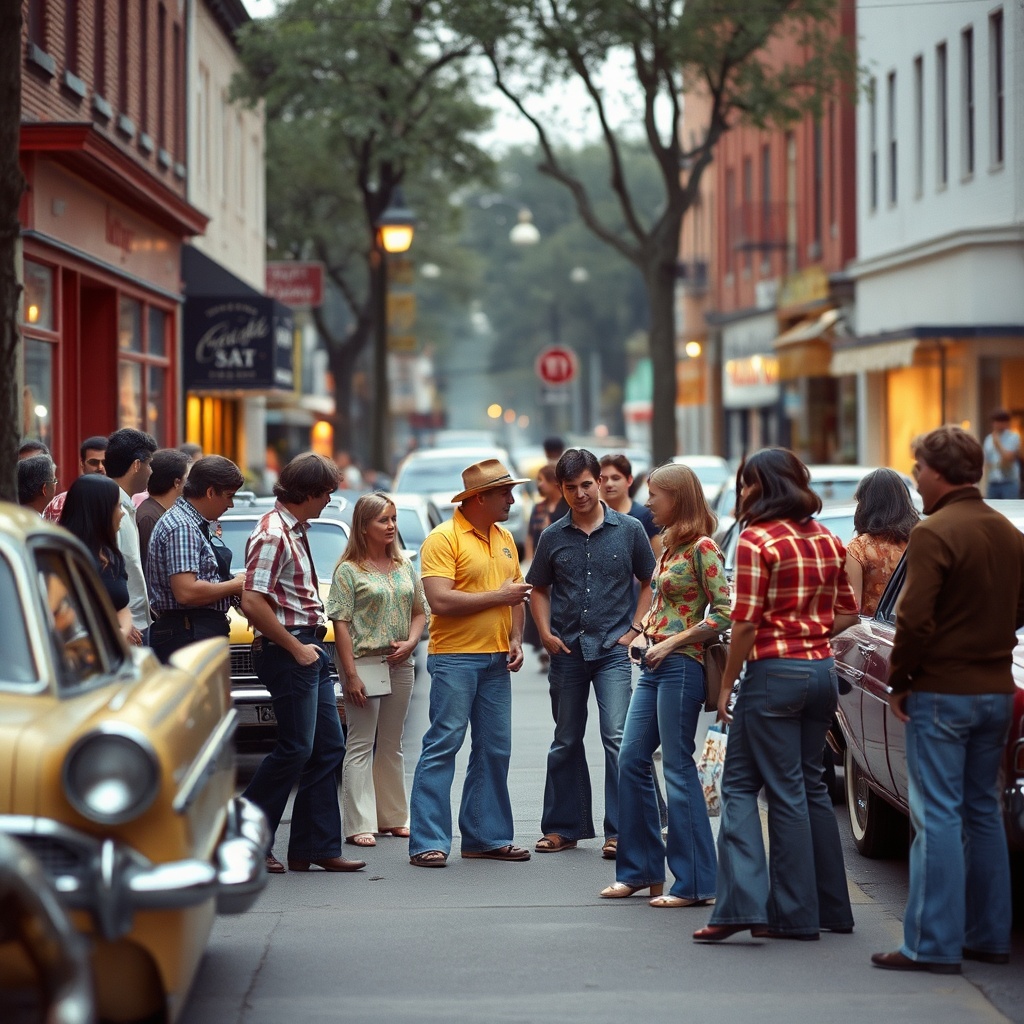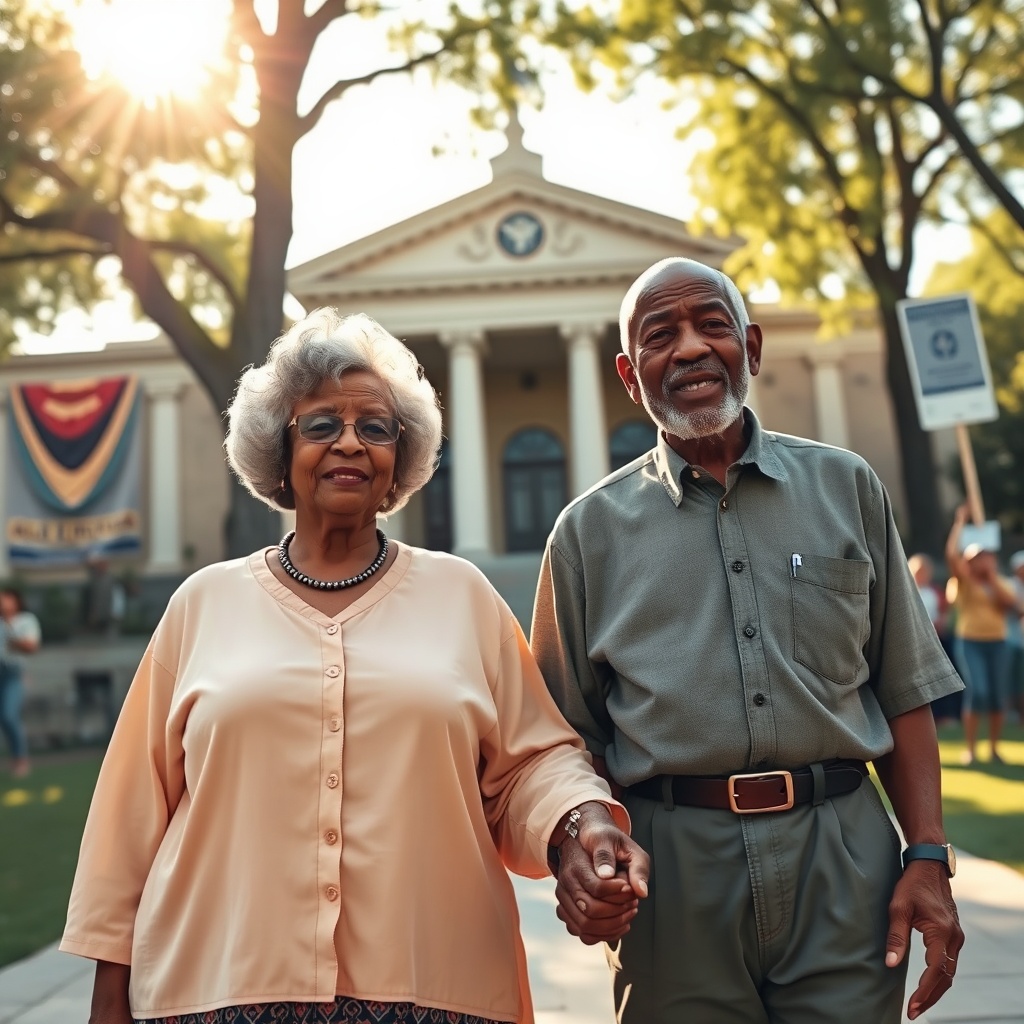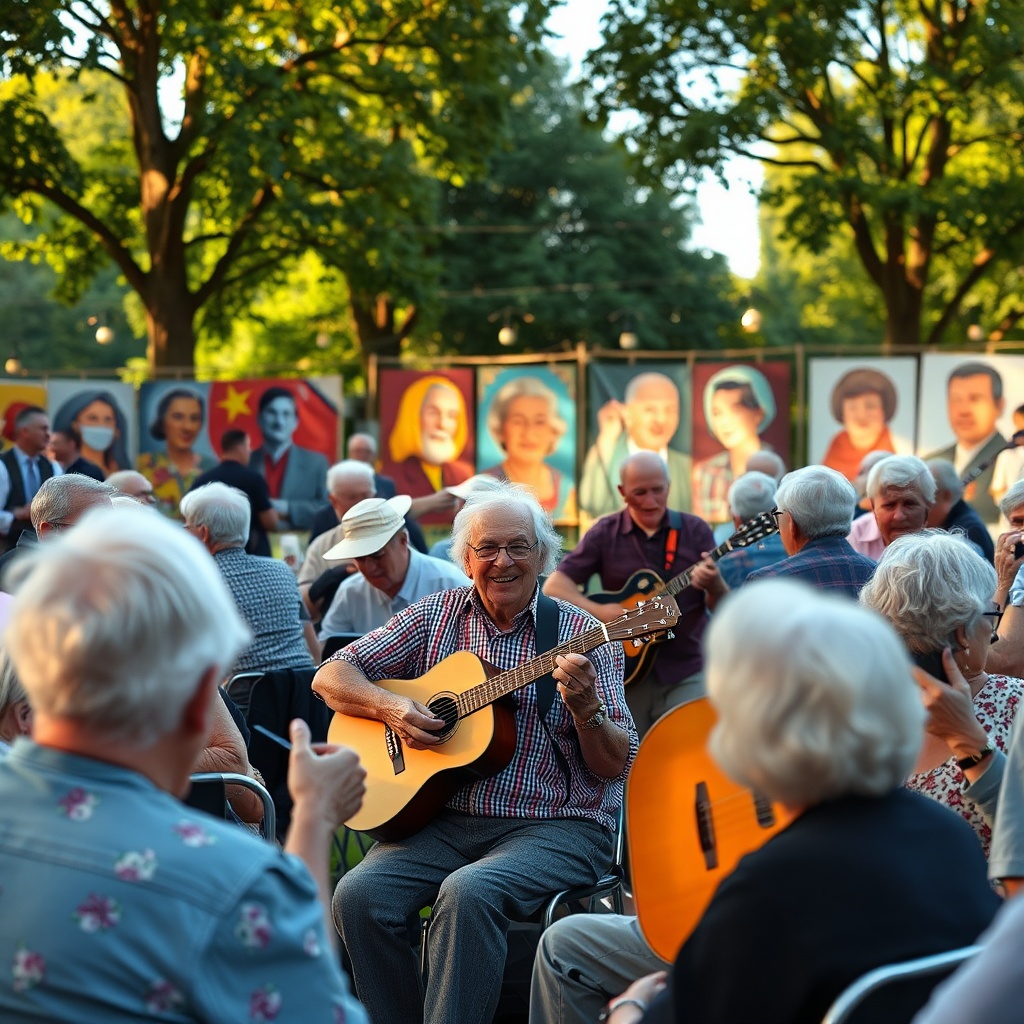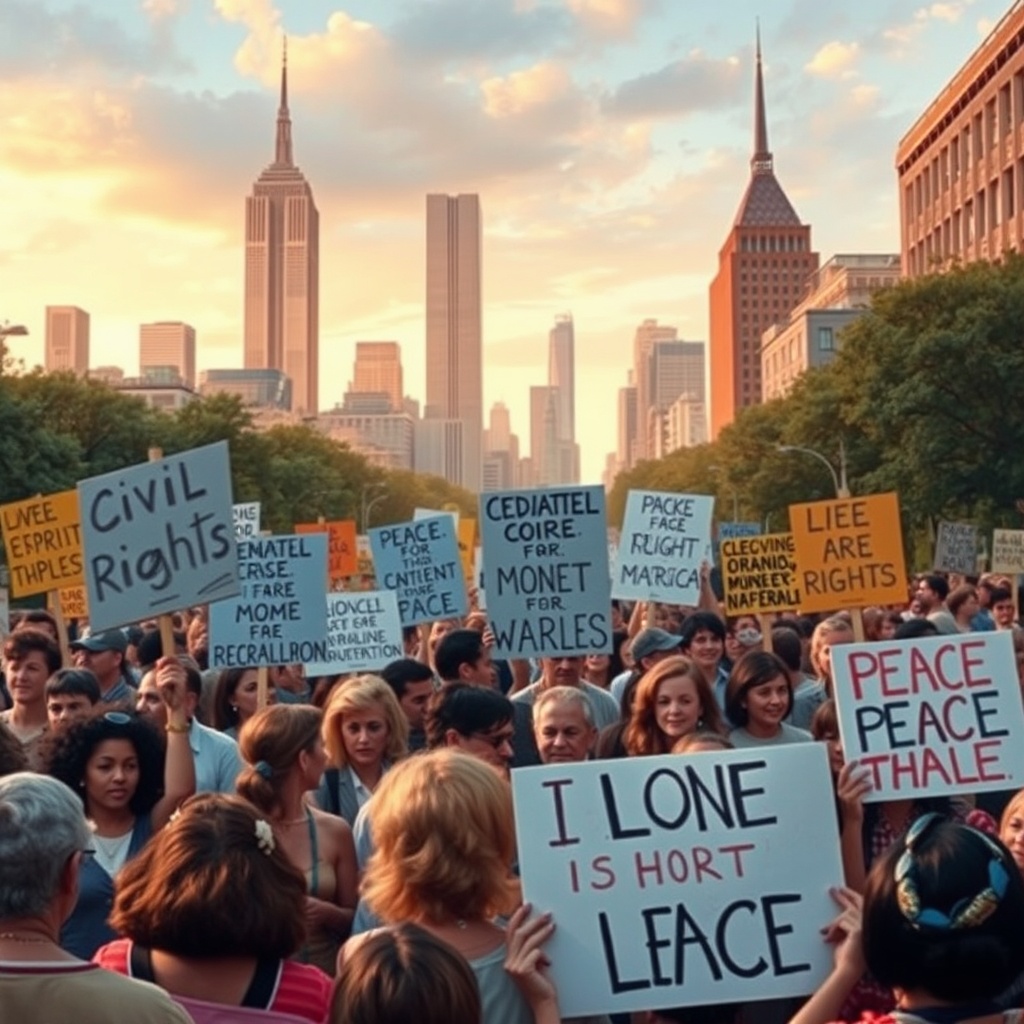Voices from the Past: Reminiscing the Turmoil of the 1960s

As we reflect on the 1960s, we find ourselves revisiting a decade that was marked by profound social change, political upheaval, and cultural evolution. This period shaped the very fabric of America, leaving behind a tapestry woven with both conflict and hope.
Key Events that Defined the Decade
- The Civil Rights Movement: A fight for equality led by figures such as Martin Luther King Jr. and Malcolm X.
- The Vietnam War: A controversial conflict that raised questions about American values and foreign policy.
- Counterculture Revolution: The rise of the hippie movement, promoting peace, love, and alternative lifestyles.
- Women’s Liberation: Advocacy for women’s rights, leading to significant societal changes.
Voices of the Era
Let us listen to the echoes of those who lived through these tumultuous times. Each voice tells a story, a memory intertwined with the struggle for justice and identity.
Personal Reflections
| Name | Experience | Impact |
|---|---|---|
| Jane Doe | Participated in the March on Washington | Inspired a lifelong commitment to civil rights |
| John Smith | Served in Vietnam | Struggled with the realities of war |
| Mary Johnson | Joined the Women’s Liberation Movement | Fostered a sense of empowerment |
Interactive Reflection
As we reminisce, consider the following questions:
- What significant events do you remember from the 1960s?
- How did these events shape your views and values?
- What lessons from that era do you think are relevant today?
The 1960s were a decade of transformation, and the voices from that time continue to resonate today. As we share these stories, we honor the struggles and triumphs that have defined our nation. Let us carry forward the lessons learned and the spirit of activism that characterized this pivotal moment in history.
The Fight for Freedom: Civil Rights and the Heart of America

In the vibrant tapestry of the 1960s, a profound struggle was unfolding across the United States. This was not merely a battle for laws and policies; it was a fight for the very soul of America. The Civil Rights Movement sought to dismantle the systemic oppression faced by African Americans and to forge a path towards true freedom and equality.
Let us take a moment to reflect on the key events and figures that shaped this monumental era.
Key Events
- The Montgomery Bus Boycott (1955-1956): Sparked by Rosa Parks’ brave refusal to give up her seat, this event marked a significant turning point in the fight against segregation.
- The March on Washington (1963): Over 250,000 people gathered to demand civil and economic rights for African Americans. Martin Luther King Jr.’s iconic ‘I Have a Dream’ speech resonated deeply, calling for a united America.
- The Civil Rights Act (1964): A landmark legislation that prohibited discrimination based on race, color, religion, sex, or national origin, this act was a monumental victory for activists.
- The Voting Rights Act (1965): This critical legislation aimed to eliminate barriers to voting for African Americans, ensuring their voices would be heard in the democratic process.
Influential Figures
| Name | Contribution |
|---|---|
| Martin Luther King Jr. | A leader of nonviolent protest, advocating for civil rights through powerful speeches and peaceful demonstrations. |
| Rosa Parks | Her act of defiance sparked the Montgomery Bus Boycott, becoming a symbol of the struggle against racial injustice. |
| Malcolm X | A proponent of black empowerment and a more militant approach to civil rights, challenging the status quo. |
| John Lewis | A key figure in the Student Nonviolent Coordinating Committee (SNCC) and a leader in the Selma to Montgomery marches. |
As we delve into this critical chapter of American history, consider the following questions:
- What memories do you have of the Civil Rights Movement?
- How did the events of the 1960s influence your views on equality and justice?
- What lessons can we carry forward from this era into today’s struggles for freedom?
This period was characterized by a chorus of voices demanding change, echoing through the streets and halls of power. The courage displayed by individuals and communities continues to inspire generations to stand up for their rights. The fight for freedom is an ongoing journey, and the heart of America beats strongest when all voices are heard and valued.
Cultural Revolutions: Music, Art, and the Spirit of Change

Introduction to the 1960s Cultural Landscape
The 1960s was a decade marked by profound cultural revolutions that reshaped the American identity. As the nation grappled with issues of civil rights, war, and personal freedom, art and music emerged as powerful tools for expression and change.
The Soundtrack of a Generation
Music became the heartbeat of the 1960s, reflecting the struggles and aspirations of a generation. Artists like Bob Dylan, The Beatles, and Janis Joplin used their platforms to challenge the status quo.
| Artist | Key Song | Message |
|---|---|---|
| Bob Dylan | “The Times They Are A-Changin’” | A call for social change |
| The Beatles | “All You Need Is Love” | A message of peace and unity |
| Janis Joplin | “Piece of My Heart” | A cry for emotional freedom |
The Visual Revolution
The art scene in the 1960s was equally vibrant, as artists sought to break free from traditional norms. Movements like Pop Art and Abstract Expressionism reflected the chaotic spirit of the time.
Consider the works of Andy Warhol and Jackson Pollock, who challenged perceptions of art and society.
| Artist | Movement | Notable Work |
|---|---|---|
| Andy Warhol | Pop Art | Campbell’s Soup Cans |
| Jackson Pollock | Abstract Expressionism | No. 5, 1948 |
As we reflect on this transformative decade, consider the following questions:
What song from the 1960s resonates with you the most, and why?
Which artist’s work do you believe best represents the spirit of change during this era?
How do you think the cultural revolutions of the 1960s influence today’s society?
The cultural revolutions of the 1960s were not merely artistic movements; they were manifestations of a deeper yearning for change. The music and art of the time continue to echo in today’s world, reminding us of the power of creativity in the face of discord.
The Shadows of War: Vietnam and the American Conscience
As we traverse the turbulent landscape of the 1960s, one cannot overlook the profound influence that the Vietnam War had on the American psyche. This conflict, often dubbed ‘the first televised war,’ exposed the stark realities of combat and prompted a national crisis of conscience.
Key Themes:
- The Dissonance of Patriotism: The war raised questions about the very essence of patriotism.
- The Role of Media: Television brought the brutality of war into living rooms across America.
- Protests and Counterculture: A burgeoning dissent against the war effort became emblematic of a generation.
The Dissonance of Patriotism
Many Americans were torn between their duty to support their government and their moral objections to the war. This internal conflict manifested in various ways:
- Some viewed service in Vietnam as an honorable sacrifice.
- Others, particularly students and activists, saw it as an unjust imperialist endeavor.
The Role of Media
The Vietnam War was the first major conflict to be extensively covered by television. This unprecedented access led to:
- Graphic imagery that shocked viewers and altered public perception.
- Live broadcasts of protests, which galvanized further dissent.
Protests and Counterculture
As the war dragged on, the anti-war movement gained momentum. The voices of dissent became a powerful counter-narrative to governmental rhetoric:
- College Campuses: A hotbed for activism, students organized marches and sit-ins.
- Prominent Figures: Influential individuals like Martin Luther King Jr. spoke out against the war.
Legacy of the Vietnam War
The consequences of Vietnam extended far beyond the battlefield:
- It reshaped U.S. foreign policy for decades to come.
- It left deep scars on the collective American conscience, raising questions about morality, justice, and the costs of war.
Reflecting on the Past
Engaging with Vietnam’s legacy prompts important reflections:
- How do we balance patriotism with ethical considerations?
- What lessons can we learn from the dissent that flourished during this era?
Discussion Questions
| Question | Reflection |
|---|---|
| What does patriotism mean to you? | |
| How has media coverage of wars changed since the Vietnam War? | |
| What role do you think dissent plays in a democracy? |
In conclusion, the Vietnam War was not just a military conflict but a pivotal moment in American history that challenged the nation’s identity and moral framework. It serves as a reminder that the echoes of discord from that era continue to resonate in contemporary discussions about war, peace, and the responsibilities of citizenship.
Generations in Conflict: How the ’60s Shaped Our Values
Imagine a time when the air was charged with hope and tension, when every street corner buzzed with debates about freedom, equality, and identity. The 1960s were not just a decade; they were a profound turning point in American history, reshaping the values that define us today. Let’s explore how the conflicts of this era have reverberated through generations.
The Civil Rights Movement
As you reflect on the Civil Rights Movement, consider the courage of individuals like Martin Luther King Jr. and Rosa Parks. Their actions ignited a fire for justice that still burns today. How did their bravery inspire you in your own life or influence your views on equality?
Think back to the March on Washington, where King’s dream echoed across the National Mall. What dreams do you hold for the future, and how have they evolved over time?
Counterculture and Social Change
The rise of the counterculture in the ’60s challenged traditional norms. Remember the Woodstock Festival? It was more than music; it was a statement of peace and love. How did this movement shape your understanding of freedom and individuality?
The anti-war protests also played a crucial role. As young people took to the streets, they questioned authority and the morality of war. How do you feel about the role of dissent in shaping a nation?
Generational Divide
Consider the divide between the Silent Generation and the Baby Boomers. The values instilled by your upbringing may have clashed with the revolutionary ideas of the younger generation. How did these differences manifest in your family discussions?
Many elderly individuals have shared stories of their parents’ disapproval of long hair, rock music, and anti-establishment sentiments. How did you navigate these conflicts within your own family?
Legacy of the ’60s
As we look back, the legacy of the ’60s is evident in today’s societal values. From civil rights to environmental awareness, the seeds planted during this tumultuous decade continue to grow. In what ways do you see these values reflected in the world around you?
As you ponder these questions, think about how the events of the ’60s have influenced your personal values and beliefs. What lessons can be passed on to the younger generations?
The 1960s were a crucible of conflict and change, shaping not just a generation but the very fabric of American society. While the echoes of discord may still resonate, they also remind us of the power of unity and understanding. What can we learn from this era to foster harmony in today’s world?
Women Rising: The Feminist Movement and Its Legacy
Understanding the Feminist Movement
The 1960s marked a turning point in American history, especially for women. The feminist movement emerged as a powerful force challenging traditional roles and advocating for equality. Have you ever wondered what inspired such a profound change? Let’s explore the roots, milestones, and lasting impact of this vital movement.
Key Figures and Events
Several remarkable women led the charge for equality:
- Betty Friedan: Author of The Feminine Mystique, Friedan questioned the roles of women in society.
- Gloria Steinem: A prominent activist and journalist, she co-founded Ms. Magazine, providing a platform for women’s voices.
- Shirley Chisholm: The first African American woman elected to Congress, she fought for the rights of marginalized groups.
Important events like the 1963 Equal Pay Act and the 1972 Title IX legislation were pivotal in promoting gender equality.
The Challenges Faced
The journey was fraught with challenges. Women faced significant opposition from traditionalists and societal norms. Did you experience or witness any of these struggles? It’s essential to acknowledge the resilience required to confront and overcome these barriers.
The Legacy of the Movement
Today, the legacy of the feminist movement continues to influence society:
- Greater Workforce Participation: More women are in the workforce than ever before.
- Educational Opportunities: Women now have access to higher education and professional fields.
- Continued Advocacy: Modern movements like #MeToo highlight ongoing issues of harassment and inequality.
Reflecting on the Past: What does the feminist movement mean to you personally? Have you seen changes in your lifetime that reflect this progress?
Engaging with the Future
As we look forward, it’s crucial to continue advocating for gender equality. How can we ensure that the voices of all women are heard? Engaging in discussions, supporting women-led initiatives, and educating younger generations are vital steps in this journey.
The feminist movement of the 1960s was not just a moment in time; it was a catalyst for ongoing change. What role do you think you play in this continuing story? Your experiences and insights are invaluable as we reflect on the past and work towards a more equitable future.
Hope and Despair: The Duality of the American Dream
The 1960s were a transformative era in American history, characterized by a complex interplay of hope and despair. As we delve into this duality, let us explore how the American Dream was both a beacon of possibility and a source of disillusionment for many.
Hope emerged from various movements that sought to redefine the very essence of the American Dream. The civil rights movement, for instance, galvanized a nation to confront systemic inequalities. Imagine the passionate speeches of leaders like Martin Luther King Jr., as they inspired countless individuals to envision a future where freedom and equality were not just ideals, but realities.
In stark contrast, the Vietnam War cast a long shadow of despair over the decade. Many young Americans, fueled by hope for a better world, found themselves disillusioned as they questioned the morality of their government’s actions overseas. The protests that erupted across the nation serve as a stark reminder of this struggle. How did it feel to stand amidst thousands, chanting for peace, while grappling with the fear of what awaited our soldiers?
As we reflect on this period, consider the impact of cultural icons. Music, art, and literature flourished, giving voice to both the aspirations and frustrations of a generation. Songs like “The Times They Are A-Changin’” by Bob Dylan captured the spirit of the times, resonating with those who dared to dream. Yet, for every note of hope, there were stories of struggle and loss. How did these artistic expressions shape your understanding of the American Dream?
The space race also exemplified this duality. The moon landing in 1969 was a monumental achievement, symbolizing the pinnacle of human ingenuity and the realization of dreams. However, it was juxtaposed against the backdrop of societal unrest, where many questioned the priorities of a nation that could send a man to the moon but struggled to address the needs of its most vulnerable citizens. What emotions did this contrast evoke in you?
Ultimately, the 1960s remind us that the American Dream is not monolithic; it is a tapestry woven from threads of both hope and despair. As we navigate our own lives, the lessons from this era encourage us to embrace the complexities of our dreams. Can we find the strength to hold onto hope while acknowledging the challenges that accompany it?
In closing, let us reflect: How do you perceive the duality of the American Dream today? What experiences from the 1960s resonate with your own journey?
Echoes of Resistance: Protests that Changed a Nation
In the tumultuous decade of the 1960s, America witnessed a series of protests that echoed through the halls of history, shaping the very fabric of the nation. These protests were not merely events; they were transformative movements that challenged the status quo and demanded change.
The Civil Rights Movement was a pivotal force in the 1960s, igniting a fire that demanded equality and justice for African Americans. Activists like Martin Luther King Jr. and Rosa Parks led peaceful protests, sit-ins, and marches, rallying thousands to their cause. Can you recall the powerful words of Dr. King in his ‘I Have a Dream’ speech? His vision for a united America continues to inspire.
The Anti-Vietnam War Protests
As the Vietnam War escalated, so did the opposition. Young people, students, and veterans took to the streets in massive demonstrations, showcasing their discontent. Woodstock, a music festival turned protest, symbolized the counterculture movement. Did you attend any protests or rallies during that time? Share your experiences!
The Women’s Liberation Movement
The 1960s also saw the rise of the Women’s Liberation Movement, where women fought for equal rights, reproductive freedom, and an end to gender discrimination. Events like the Miss America Protest in 1968 drew attention to the societal expectations placed upon women. How do you think these protests reshaped women’s roles in society?
Native American Rights
Indigenous peoples also began to assert their rights during this decade. Protests such as the Trail of Broken Treaties in 1972 brought attention to the injustices faced by Native Americans. Their fight for sovereignty and respect continues today. What are your thoughts on the ongoing struggle for Native American rights?
The protests of the 1960s were not just fleeting moments; they were the echoes of resistance that resonated through the ages. Each protest, each voice raised in defiance, contributed to a narrative of change that continues to influence today’s society. As we reflect on these events, what lessons can we draw from the past to inspire future generations?
The Power of Unity: Community Organizing in the 1960s
In a decade marked by turmoil and transformation, the 1960s witnessed a remarkable surge in community organizing. This movement was not merely about addressing local issues; it was about forging connections and building a sense of unity that transcended individual struggles.
Imagine a time when people gathered in town halls, churches, and living rooms, fueled by a shared desire for change. Can you recall any such gatherings from your own experiences? These meetings often became the crucible for collective action, where voices that had long been silenced found strength in numbers.
At the heart of this movement were individuals who recognized that unity was their greatest weapon against the injustices they faced. Leaders emerged, often from within the very communities they aimed to uplift. They understood that organizing was about more than just protests; it was about empowering individuals to take charge of their own destinies.
Take, for example, the work of groups like the Student Nonviolent Coordinating Committee (SNCC) and the Southern Christian Leadership Conference (SCLC). These organizations played pivotal roles in mobilizing communities to engage in nonviolent protests, voter registration drives, and grassroots activism. Do you remember how these movements influenced your community?
As communities came together, they began to tackle issues ranging from civil rights to economic inequality. The fight against segregation in schools and public spaces brought neighbors together, fostering relationships that transcended race and background. What stories do you have about unity in your community during these times?
Through rallies, sit-ins, and community forums, people learned the importance of listening to each other, sharing their stories, and working collaboratively to find solutions. The power of unity became evident as communities rallied around common goals, demonstrating that collective action could indeed bring about significant change.
As we reflect on the lessons of the 1960s, it’s essential to remember that community organizing is not just a relic of the past. It continues to be a vital tool for social change today. How can we apply the lessons learned from the unity forged in the 1960s to the challenges we face now?
In conclusion, the 1960s taught us that when individuals come together in solidarity, they can challenge the status quo and reshape the future. The power of unity not only defines the spirit of community organizing but also serves as a beacon for future generations seeking to bring about meaningful change.
Lessons Learned: Reflecting on the 1960s for Today’s America
Understanding the 1960s
The 1960s was a decade defined by social upheaval and cultural transformation. It was a time of great discord, but also of profound change. As we reflect on this pivotal era, let’s consider how its lessons resonate in today’s America.
Key Lessons from the 1960s
What can we learn from the struggles and triumphs of the 1960s? Here are some essential lessons:
Unity in Diversity: The Civil Rights Movement taught us the importance of coming together across differences. Today, how can we foster unity in our diverse society?
The Power of Activism: The protests and movements of the 60s showed that collective action can lead to significant change. Are we using our voices effectively today?
Questioning the Status Quo: The decade encouraged a generation to challenge norms and seek justice. In what ways can we continue to question and improve our societal structures?
Importance of Media: The role of television and print media in shaping public opinion was crucial. How does today’s media influence our perception of reality?
Now, let’s take a moment to reflect:
Think about an event from the 1960s that impacted you. What feelings did it evoke?
Consider current events. How do they echo the struggles or victories of the past?
In your own life, how can you apply the lessons of activism and unity?
Bridging Generations
As we navigate today’s challenges, it’s crucial to engage younger generations in discussions about the past. Sharing stories and experiences can create a bridge between ages, fostering understanding and collaboration.
The 1960s were not just a chapter in history; they are a guide for how we can approach the complexities of our society today. By embracing the lessons learned, we can work towards a more unified and just America.
